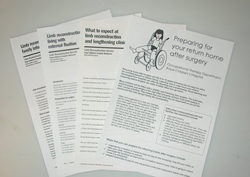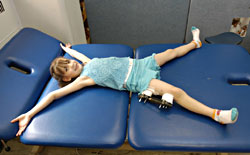Prior to undertaking a Limb Reconstruction and Lengthening
procedure, there is a definite path that needs to be followed.
Education:
As part of the education process, the child and family will meet
with the Orthopaedic and then Multi - disciplinary team.
The Orthopaedic team consists of:
A/Professor Leo Donnan -Consultant Orthopaedic Surgeon
Mr Chris Harris - Consultant Orthopaedic Surgeon
Ms Cheryl Dingey - Nurse Co-ordinator
Mr Greg Cull - Physiotherapist
Ms Erin Lowrie - Occupational Therapist
Mr Hamish MacLeod - Educational Consultant
It is the nurse co-ordinator's role to facilitate all education
and preparation of the patient for surgery.
As part of the preparation, each child will attend the Limb
Reconstruction Clinic.
This involves a through assessment of the child's affected limb
and a full examination of their walking
Clinical photographs may also be taken at this point. Further to
this appointment, other investigations may be ordered.
Copies of all education brochures will be provided at this
visit, if not already given to the family.

Radiographs:
These must be completed prior to the child progressing to
theatre. This is to allow the surgeon time plan out the procedure
in advance, and to pre-order any specific equipment or stock if
needed.
Clinical Photographs:
Clinical Photographs are a permanent record of the child's
progress through the Limb reconstruction phase. Pre-operative
photos serve to remind both the team and the child/family what
the deformity looked like before. Progress photographs are often a
useful tool also, to map the changes occurring. These may be done
via Digital file or in the hospital photographic studio: in all
cases an informed consent must be obtained. It is suggested that a
photograph of the consent form also be taken prior to each group of
photos being taken.
Physiotherapy Assessment:
A detailed examination of each child is required. It is
suggested that a standard examination form is developed to ensure
that each child has the same examination performed and these are
stored by the assessor and added to at each visit. A copy should
also be filed in the patient's Medical record.
Continued record keeping of assessment is vital to detect even
slight deterioration in the patient's progress, which in turn means
that quick action is possible.
An individual program is developed for each child in the
rehabilitation phase.
